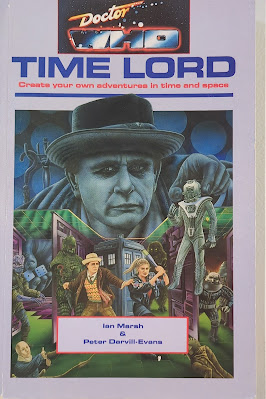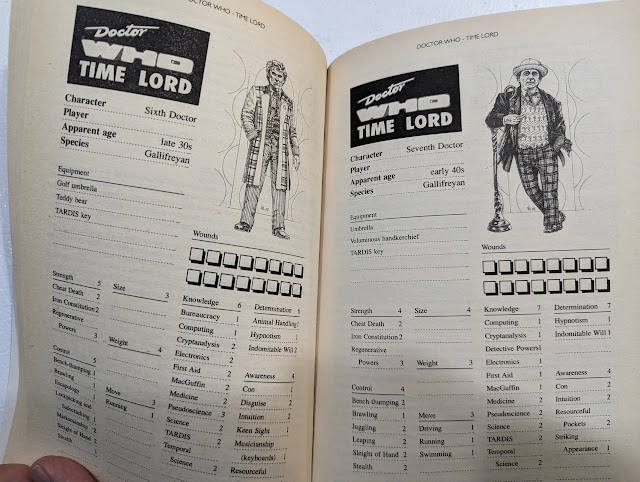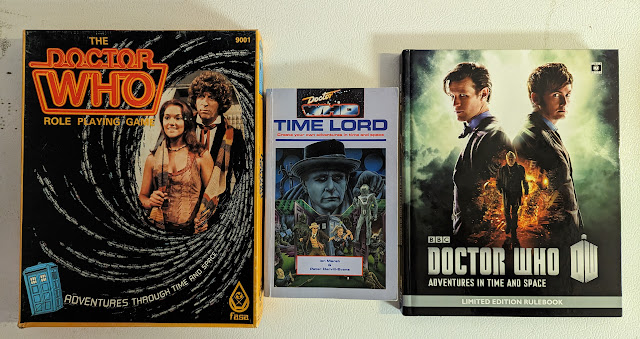The Doctor had seen something of a resurgence in the Sylvester McCoy years leading to Virgin Books (founded by Richard Branson) to continue the story of the Doctor and Ace in the "New Adventures" series. The novels were very popular among Doctor Who fans, even if they took some liberties with the established lore of the show. Though some ideas (like the Time War and Other) would find new life in the 2005 reboot of the series. But that is for another discussion.
While Virgin saw success with the novels, they found getting into the RPG market a little more difficult. They released Doctor Who Time Lord with the subtitle Create your own adventures in time and space in 1991. The book was in an A5 (148.5 x 210 mm or 5.8 x 8.3 inches) format as a novel. The authors were Ian Marsh and Peter Darvill-Evans. Both of whom had solid RPG and Doctor Who credentials. The game has been out of print for a while, but the authors had released a copy of it online. You can still find it if you know where to look. I compared it to my print copy, and they were identical save for some updates to include the then-new Eighth Doctor.
Time Lord
1991. 288 pages, A5. Color covers, black & white interior art and photos.
The presentation for this game is an odd one, since it came from a novel publisher rather than an RPG one.
PART ONE: DOCTOR WHO: A Legend In Its Own Primetime
This covers the history of the Doctor Who programme from 1963 to 1989. It gives us details on the seven actors to play the Doctor. We are introduced to some concepts in Doctor Who like the TARDIS and the Companions as well. There is also a short story, The Necromancers, that is referred too later in examples.
PART TWO: Role-Playing: What It Is And How To Do It
This covers the basics of RPGS including a history lesson complete with nods to Dungeons & Dragons. It is not a bad overview really. Designed mostly I think for Doctor Who fans that are not roleplayers already. There is a solitare adventure you can play, Switchback, with the characters Jamie and Tegan as your examples. I am just trying to imagine a situation where these two would be working together. It is more or less like a "Choose your own Adventure" sort of deal. Similar to the one found in the D&D BECMI Basic book, but you won't be carrying Tegan's lifeless body back when you are done.
PART THREE: How To Role-Play A DOCTOR WHO Adventure
This covers the basic rules of Time Lord. The system uses two six-sided dice (like the other DW RPGs) but in this one you take the difference to get your number. So the results will be 0 to 5, with 5 (6-1) being the best role. You compare an ability to a difficulty set by the Referee. If your Ability score is lower than the difficulty score then you must roll and score higher than the difference. So if your ability is Strength 3 (average) and the difficulty for a test of strength is a 5 then you need to roll a 2 or better. Difficulty can be adjusted as the Referee needs. There are some examples given in the book and appendix.
The Abilities include Strength, Control, Size, Weight, Move, Knowledge, Determination, and Awareness. All (save Weight) have special abilities attached to them. The special abilities are all detailed and work like a combination of skills and advantages.
Combat is covered, though Doctor Who is not a combat-focused game in any iteration, there is some here. It should be noted that in Time Lord, unless you are the Doctor, death is permanent.
PART FOUR: The Cast of Thousands
This section might be where Time Lord shines above FASA's Doctor Who game. Here we have stats for all Seven of the Doctor's incarnations and all 29 of his companions, from Ace to Zoe. We also get a lot of aliens andvillains (though not sure why Sabalom Glitz is here, he is more of a comic-relief character). The Master and the Monk are two separate figures in this game.
There is some coverage on various vehicles including space and time travel ones. Special attention is given over to the TARDIS as expected.
There is even a section called "500 Year Diary" (something that just popped up in a recent Doctor Who episode I was watching too!) that briefly covers a few topics.
PART FIVE: The Never-Ending Script
This covers running a game. It also gives good examples of what the various levels of Abilities are. While humans range from 1 to 5, with 3 being average, the scale does go to 10. So for example a "comic book superhero" has Control 7 and a Time Lord like Rassilon has Knowledge 9.
There are plenty of examples of Difficulty modifiers and relative percents. So really there are some really great details here. There are details and tips on creating your own adventures and a sample adventure The Templar Throne (or Curse of the Cyclops in the PDF) is provided.
APPENDIX 1: CREATING COMPANIONS
There are no character creation rules really in this game. The rule expects you will be playing the parts of one of the Doctors and his various companions. This Appendix though does give you guidelines on how to create your own companions. A sample companion, Alison, is given.
APPENDIX 2: SAFE COMBAT
This covers how to tone down the lethal-ness of combat.
APPENDIX 3: DESIGNER’S NOTES
Now this is pretty interesting. The designers talk about why the made the game the way they did and how to want to appeal to both sorts of fans, Doctor Who and RPG players.
APPENDIX 4: ADVANCED CHARACTER CREATION
Now this is from the PDF version only. The print version does not have this. This addresses the original criticism that the game did not feature character generation rules. This takes the guidelines found in Appendix 1 and expands them to includes combined a point spread generation and a random number generation. This produces characters that are all roughly of the same sort of spread with some exceptional abilities thrown in. Much like the companions themselves.
Note: There are still no rules here for generating a Time Lord character. Unless that character is a Gallifreyian and a companion of the Doctor, like Susan or Romana.
Both end with blank character sheets. The book also includes blank sheets for Aliens and Villian NPCs.
I had grabbed this PDF back in the dawn of the Internet and held on to it for years, not really knowing what I had had. It wasn't until I saw the Virgin book on sale that I finally put it all together.
The Time Lord game is very much a product of the 90s and the Virgin New Adventures here really shine through. Granted that could just be me reading into it all. I had a rather nice collection of those books, and it colored my view of the Seventh Doctor (for the better really).
The game is not groundbreaking by any stretch, but it is much better than I originally gave it credit for and would have been great fun in the dry years following the Fox Doctor Who movie.
Given the use of two d6s instead of grabbing them from your "Monopoly or Risk" games as the book suggests you can borrow some from it's sibling games that also use d6s.





1 comment:
Oh, yeah, a "D6" would be a normal dice. lol
Who wants to make their combat less lethal? That doesn't seem like any fun.
Post a Comment